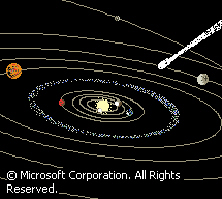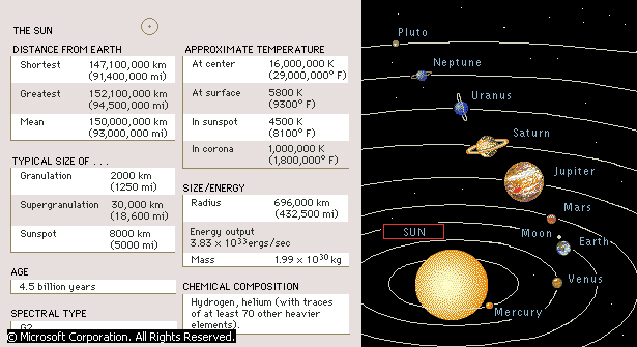
Planetary Science is the study of the forces and influences that determine the composition, structure, and evolution of planets and planetary systems. Planetary scientists also study how planetary systems form around other stars. In particular, planetary science is a study of the properties of the earth compared to the properties of other worlds, which helps explain some of the properties of the earth through the example of other planets.
Astronomers believe that planetary systems are formed of materials that were created in the interiors of giant stars and then blasted into space when the stars exploded. According to the currently accepted views, the most likely first stage in the evolution of a planetary system is a supernova, an explosion of one of these giant stars, which sends shock waves through nearby clouds of interstellar dust and gas. A shock wave may compress a nearby cloud to a sufficiently high density that the weak attractive force of gravitation is made strong enough to cause the cloud to collapse in on itself. The gravitational attraction of particles for each other and collisions between the particles of the cloud cause the cloud to form a large central body known as a protostar, encircled by a thin disk of dust, gas, and debris known as a planetary disk. In the case of the earth's solar system, the protostar eventually became the sun and the planetary disk broke up into the planets of the solar system. By studying our own planetary system, planetary scientists gain insight into the general mechanisms that determine the structure of planetary systems.
 As
an interstellar cloud begins to contract into a star, any random
swirling motion in the cloud becomes more orderly and translates into
a general rotation of the entire cloud. As the cloud continues to
contract, its speed of rotation increases, just as figure skaters
spin faster as they pull in their arms. The physical principle for
this is known as the conservation of angular momentum, and it means
that the total angular momentum of the cloud must remain constant.
Because angular momentum depends on the distance of the mass from the
center of rotation and the speed of rotation, as the distance
decreases, the speed must increase to compensate and keep the
momentum constant. In an interstellar cloud, this means that as
distant parts of the cloud move closer to the center of rotation, the
speed of the cloud's rotation must increase.
As
an interstellar cloud begins to contract into a star, any random
swirling motion in the cloud becomes more orderly and translates into
a general rotation of the entire cloud. As the cloud continues to
contract, its speed of rotation increases, just as figure skaters
spin faster as they pull in their arms. The physical principle for
this is known as the conservation of angular momentum, and it means
that the total angular momentum of the cloud must remain constant.
Because angular momentum depends on the distance of the mass from the
center of rotation and the speed of rotation, as the distance
decreases, the speed must increase to compensate and keep the
momentum constant. In an interstellar cloud, this means that as
distant parts of the cloud move closer to the center of rotation, the
speed of the cloud's rotation must increase.
A nonrotating cloud of interstellar gas and dust would contract into a sphere at the center of mass of the cloud, but the vast majority of objects in space rotate. Frictional drag within the cloud and other dynamic interactions cause the outer parts of the rotating cloud to flatten into a disk that surrounds the central spherical body. Planetary systems, such as our own solar system, form from material in these so-called planetary disks. Observations suggest that planetary disks surround as many as 60 percent of the new stars in young star clusters.
 A
planetary disk heats up as it forms. Once a star forms in the
center, the rest of the disk cools by radiation. As it cools, solid
mineral grains and ice crystals condense, much as snowflakes condense
in cooling air. As the grains collide, they stick together to form
larger grains that sweep up other grains ever more quickly. The disk
around a newly forming star quickly becomes a sort of factory in
which dust grains and ice crystals aggregate and grow into
asteroid-sized bodies called planetesimals (small planets). The
planetesimals gather more material through gravitational attraction
and collision until eventually only a few planet-sized bodies are
left. In the earth's solar system, the planet-forming process
apparently happened relatively quickly. The planets reached their
present sizes and arrangement probably within 10 million to 50
million years after the sun's ignition.
A
planetary disk heats up as it forms. Once a star forms in the
center, the rest of the disk cools by radiation. As it cools, solid
mineral grains and ice crystals condense, much as snowflakes condense
in cooling air. As the grains collide, they stick together to form
larger grains that sweep up other grains ever more quickly. The disk
around a newly forming star quickly becomes a sort of factory in
which dust grains and ice crystals aggregate and grow into
asteroid-sized bodies called planetesimals (small planets). The
planetesimals gather more material through gravitational attraction
and collision until eventually only a few planet-sized bodies are
left. In the earth's solar system, the planet-forming process
apparently happened relatively quickly. The planets reached their
present sizes and arrangement probably within 10 million to 50
million years after the sun's ignition.
Study of the earth's planetary system has revealed much about the origin, evolution, and essential processes of planetary systems in general. In turn, knowledge of the general principles governing planetary systems has shed new light on the earth. The immediate practical applications of planetary science concern the preservation of the earth's environment in a state that supports life. The long-term applications of planetary science focus on the evolution of the physical structures of planetary systems and on the search for planets surrounding stars other than the sun. Scientific agencies in several countries are currently considering proposals for several projects designed to send more robotic probes to other planets, satellites, asteroids, and comets, and to detect planetary systems orbiting stars other than the sun, particularly planets like the earth.
Contributed By:
William K. Hartmann